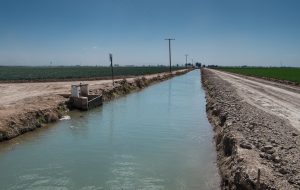For those following efforts to cobble together an expanded Colorado River water conservation deal (that’s all of you, right?) there are a couple of important issues to unpack in Ian James’ excellent interview published yesterday with Kevin Kelley, general manager of the Imperial Irrigation District. Imperial, the largest single water using agency on the Colorado, is farming 369,000 acres of desert land this year (source pdf) and is forecast to use 2.55 million acre feet of water in 2016 (source pdf). That is nearly four times the Colorado River water use currently forecast for metropolitan Southern California this year.

Wheat, right, and onions with a canal, Imperial Valley, March 2014
In other words, as measured by water use, Imperial is the major player here.
As currently structured (and this is very much a work in progress), an agreement among the states of Arizona, Nevada, and California would have California voluntarily reducing its take on the Colorado River if Lake Mead drops too low. But Californians are still sorting out the details of how allocations within California would be reduced. From James’ story:
IID and other water districts in California have been in talks about proposals to share in reductions in the amounts of water they receive from the Colorado River. Those negotiations among the state’s districts are taking place parallel to talks between representatives of Arizona, Nevada, California and the federal government.
These in-state talks, as I wrote last week, may be the hardest part of this deal-making. For Imperial, Kelley explained, a solution to the problems of the Salton Sea is crucial to any deal. Water conservation efforts in Imperial reduce flows to the sea, creating a host of environmental problem in the desert communities that surround it:
“There is no single agency with a greater stake in the river or one that could make a greater impact in propping up that plunging elevation (of Lake Mead) than IID,” Kelley said. “But IID’s participation can only come about if there is a going-forward road map at the Salton Sea.”
Kelley made a second incredibly important point in the James piece – the way important information about the current status of the California part of the deal was made public last month ago by folks in Arizona. There’s always been tension between Arizona and California over how to share the Colorado (there’s a chapter on this in my forthcoming book), and Kelley’s comments suggest concerns among at least some in California about the way Arizonans chose to make the deal public before Californians were ready:
The Arizona Department of Water Resources recently released a presentation describing some of the proposals, including potential cutbacks for each of the states – in California’s case, up to 8 percent of total water deliveries in one hypothetical scenario.
“These recent news reports out of Arizona have not been helpful to the process within California,” Kelley said. “They suggest that there’s a California commitment to specific volumes, and that is not the case.”
The politics within Arizona are crucial. That state’s historic resentment of California mean Arizona leaders trying to win support for the deal have to convince the domestic Arizona political audience that California will be saving water too. Arizona is going first here because that state’s legal structure requires legislative approval, and because Arizona as the junior water user has the most to lose if there is no deal. So I can see why a public rollout there has to be able to emphasize California’s contributions to the water conservation pool, as Arizona Department of Water Resources chief Tom Buschatzke wrote:
California would take reductions as well, but not before the lake has fallen to still lower levels. Current law states that California does not take reductions in deliveries until the Central Arizona Project completely dries up. Equity and fairness demand a different outcome.
The question raised by Kelley’s comments is whether Arizona, in being the one who revealed what’s going on internally within the California negotiations, has made it harder to reach a deal that is very much in Arizona’s interests.

Games of chicken seem quite common in water issues. Everyone has an interest in having an agreement on how shortages on the Colorado would be allocated, to more gently accommodate such shortages and have sufficient advance notice to make less costly responses, and perhaps better get federal help.
But being the first to show willingness to compromise undermines one’s negotiating position. Other parties will think they can get you to take more of the shortage.
Arizona has solved this problem by asserting that someone else (California) is more willing to compromise. Well played – at least for now. But as pointed out, this might make it harder for California to actually compromise.
A wicked problem.
More like state VS state. AZ has never trusted CA when it came to the Colorado River. Arizona didn’t sign the Compact at Bishop’s Lodge. Troops were called up during the construction of Parker Dam. AZ vs CA in 1964. The concessions made in building CAP.
The tension between these two states over water has a long history.
dg